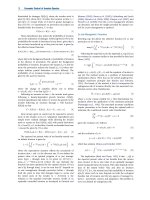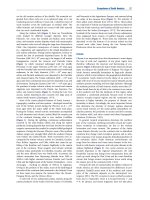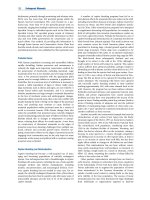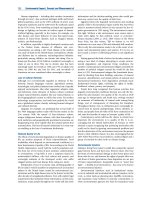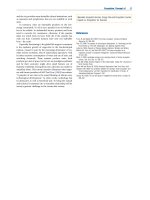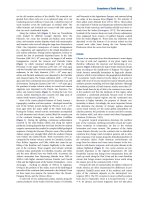Encyclopedia of biodiversity encyclopedia of biodiversity, (7 volume set) ( PDFDrive ) 1734
Bạn đang xem bản rút gọn của tài liệu. Xem và tải ngay bản đầy đủ của tài liệu tại đây (60.34 KB, 1 trang )
Elevational Trends in Biodiversity
elevations of observation (interpolation). Interpolation can
create an artificial hump in species richness along the elevational gradient if sampling is incomplete (Grytnes and
Romdal, 2008). If more detailed specimen information is
available, uneven sampling may be accounted for by using
rarefaction or extrapolation (Grytnes and Romdal, 2008),
without such information error simulations can test for pattern robustness (e.g., McCain, 2007a).
Rahbek (2005) conducted an overview of elevational
richness patterns from the literature. The majority of these
studies treated plants and he demonstrated that almost 50% of
these studies found a humped pattern, and around 25% had a
monotonic decrease with elevation. The fraction of humpshaped patterns increased to around 70% after excluding
studies that did not consider the whole gradient (Figure 1(a):
plants). Rahbek’s study also demonstrated the importance of
scale, for example, a hump-shaped pattern is more common if
a single transect is studied (i.e., alpha diversity), than if the
pattern is studied on a whole mountain range (i.e., gamma
diversity).
McCain has performed a series of global meta-analyses on
elevational richness patterns among taxonomic groups from
published studies. These and previous analyses clearly show
that the observed pattern depends on the organism studied
and the local climatic conditions (Figure 1(a); McCain, 2005,
2007a, 2009, 2010; Rahbek, 2005). Nonflying small mammals
(rodents, shrews, marsupials) almost ubiquitously demonstrate unimodal richness patterns with the highest richness
at intermediate elevations (robust, informative gradients
(RIG) ¼ 54; McCain, 2005). Bats demonstrate two global
patterns: half of the studies found decreasing species richness
with increasing elevation and the other half found unimodal
richness patterns (RIG ¼ 12; McCain, 2007a). As stated above,
Rahbek found that plants tend to show mostly unimodal
richness patterns (RIG ¼ 21; from Rahbek, 2005, Figure 3f).
Birds show more variation in their elevational richness patterns: 30% are decreasing, 43% have high diversity across most
of the lower portion of the gradient then decrease (low plateau
in diversity; e.g., Figure 1(a)), and the final 27% have unimodal richness (RIG ¼ 95; McCain, 2009). Finally, for reptiles
54% show a decreasing pattern, 25% have a low plateau, and
21% have a unimodal richness pattern (RIG ¼ 24; McCain,
2010; Figure 1(a)).
Mountain regions often host a large fraction of endemic
species (e.g., Orme et al., 2005). Considering that isolation is
an important factor for speciation; it is no surprise that fraction of endemic species tends to increase with altitude resulting in a peak in species richness at intermediate elevations
above the peak in total species richness. For vascular plants in
the highest mountains of the world the fraction of endemics
increases linearly from the lowlands to the highest point
where plants are found (around 6000 m above sea level)
(Vetaas and Grytnes, 2002). This results in a peak in endemic
richness around 4000 m, whereas the total number of species
peaks around 1500 m. Studies on avian mountain endemics
demonstrated their greatest diversity at intermediate elevations
between 1500 and 3000 m, although somewhat lower on
shorter mountains, even though overall diversity decreases
monotonically with elevation (e.g., Stotz et al., 1996). Such
contrasting patterns in total species richness and endemic
151
species richness are most likely commonplace along elevational gradients, particularly for highly diverse groups.
Discussion of Possible Causes
Elevational gradients are invaluable for discerning between
diversity hypotheses. The small spatial scale, the thousands
of independent replicates on mountains across the globe
of various heights and in various climates, the high variability
in richness patterns among taxonomic groups, and the
predictable trends in abiotic factors with elevation allow
globally distributed elevational gradients to be used as natural
experiments, allowing for rigorous testing of hypotheses. The
causes commonly mentioned for elevational patterns in species richness are very similar to the causes used to explain
other broad-scale factors in species richness. These can be
grouped into four categories: climatic hypotheses based on
current abiotic conditions, spatial hypotheses of area and
spatial constraint, historical hypotheses invoking processes
occurring across evolutionary time scales, and biotic hypotheses (e.g., community overlap (ecotones), source–sink dynamics, and habitat heterogeneity). Below the authors
describe some of the most commonly asserted hypotheses and
assess their current level of support.
Climatic Hypotheses
Climatic variables like temperature, rainfall, and productivity
are probably the most commonly cited causes for broad-scale
patterns in species richness and elevational patterns are no
exception. Temperature has a simple relationship with altitude
as it decreases monotonically by 0.3–0.6 1C per 100 m elevational gain. Rainfall often follows a more complex relationship with altitude and maximum rainfall is often found at
intermediate elevations, but is also known to increase with
elevation or be high across a broad band of low to intermediate elevations. In tropical areas the zone of maximum
humidity often corresponds to the cloud zone and horizontal
precipitation from low-lying clouds can significantly increase
the water availability at those elevations.
Climate may affect elevational species richness patterns in
several ways. First, climatic tolerances of the studied species
may put restrictions on how many species that can survive at
different elevations. This will have different effects on different
species groups, and may be a result of their evolutionary history and niche conservatism (Wiens et al., 2010). Some species
groups (e.g., epiphytic plants, salamanders) are dependent on
high and constant moisture, whereas others may be restricted
by a certain winter temperature. As a result, different species
groups will show different elevational richness patterns,
exactly what was demonstrated by Whittaker’s early studies
and confirmed by McCain’s meta-analyses. Second, species
richness may depend on productivity through the number of
individuals that are found in an area. Higher productivity
leads to higher number of individuals, which in turn leads to
higher species richness. Primary productivity is dependent on
temperature and precipitation. Because rainfall in many cases
increases with elevation or has a humped relationship with
